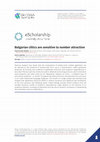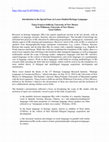Books by Tanya Ivanova-Sullivan
In Theoretical and Experimental Aspects of Syntax-Discourse Interface in Heritage Grammars,Tanya ... more In Theoretical and Experimental Aspects of Syntax-Discourse Interface in Heritage Grammars,Tanya Ivanova-Sullivan investigates comprehension and production of anaphoric dependencies with null and overt subject pronouns. She discusses the divergent behaviour of the heritage speakers of Russian by providing a closer look at their proficiency level, quantity of input and order of language acquisition. She explains the results with various degrees of successful application of pragmatic principles and efficiency in allocating cognitive resources.
The contribution of the monograph lies in the discussion of theoretical and experimental issues related to anaphora resolution along with an investigation of all aspects of representation and processing of anaphoric pronouns by heritage speakers, L2 learners and L1 attriters.
Book chapters by Tanya Ivanova-Sullivan

Essays in Honor of Maria Polinsky, 2025
The early stages of lexical development in children pose various questions
about the selection an... more The early stages of lexical development in children pose various questions
about the selection and application of word-learning heuristics. In many proposals these processes are assumed to be facilitated by a specific lexical bias that differs in strength in monolingual and bilingual populations, namely, the Mutual Exclusivity (ME) bias (Markman & Wachtel 1988; Houston-Price et al. 2010). The present study analyzes the role and operation of ME bias in the bilingual vocabulary acquisition of
a child who is acquiring Bulgarian and English from birth in the US. The analysis focuses on the child production of translation equivalents (TEs) at three measurement points: 18, 24 and 30 months. The findings reveal a flexible use of the ME bias modulated by the child bilingual linguistic experience and his emerging understanding of word-concept mappings in different contexts.

The Cambridge Handbook of Slavic Linguistics, 2024
Since the publications of the state-of-the-art reviews of first language (L1) acquisition (Ionin ... more Since the publications of the state-of-the-art reviews of first language (L1) acquisition (Ionin & Radeva-Bork 2017), second language (L2) acquisition of Slavic languages (Gor 2017), Slavic psycholinguistics (Sekerina 2017) in the Journal of Slavic Linguistics, and an edited volume on empirical and experimental research (Anstatt et al. 2016), psycholinguistic research on Slavic languages has experienced a true explosion of new insights. These review articles help document this development focusing on different populations, methods, domains, theoretical approaches, and languages, and analyzing experimental studies in Slavic morphosyntax, lexical, and sentence processing. Our chapter organically follows and elaborates on these discussions, thus delineating the current general trends and future directions in Slavic psycholinguistics. We will primarily focus on the monolingual and bilingual L2 populations, whereas the early bilingual heritage speakers of Slavic languages are surveyed in Chapter 31. We review some of the topics that have received the most attention, such as acquisition and processing of the phenomena in the nominal (i.e. gender, case) and verbal domains (i.e. aspect and predicate-argument structure), as well as monolingual and bilingual language representation and processing of syntactic dependencies in Slavic. Our goal is to achieve a balance between depth and breadth of analysis, thus offering a rich 'access point' (cf. Rothman et al. 2018) to a field that has been steadily moving from the periphery of Slavic studies to its center (Nedashkivska 2011). An increasing number of Slavic psycholinguistic studies are advancing Slavic grammatical theories and rapidly adopting cutting-edge experimental methods from general psycholinguistics. This bidirectional relationship between language acquisition and theory construction in
Brill's Encyclopedia of Slavic Languages and Linguistics, 2023
This entry discusses the comprehension and processing of Slavic heritage languages spoken in Nort... more This entry discusses the comprehension and processing of Slavic heritage languages spoken in North America and Europe. The main focus is on the processing patterns and outcomes documented in adult heritage Russian, Polish and Bulgarian and the impact of language-internal factors, cross-linguistic transfer, and sociolinguistic variables (proficiency level, age of onset, and quantity and quality of input, among others). The survey highlights the increased attention to Slavic heritage language processing and its bi-directional relation to linguistic theory.
The Soft Power of the Russian Language: Pluricenticity, Politics, and Policy, 2019

And Thus You Are Everywhere Honored: Studies Dedicated to Brian Joseph, 2019
In this article, we examine the origins and the development of wine culture in Slav-ic-speaking a... more In this article, we examine the origins and the development of wine culture in Slav-ic-speaking areas beginning in prehistoric times and continuing until the late Pro-to-Slavic period. We discuss linguistic and archeological evidence to trace the PSl term *vino by focusing on different hypotheses about its origin as a native inheritance from PIE vs. borrowing in a later period from Latin or Germanic. The goal of our analysis is to reevaluate phonological, suprasegmental, and morphological data related to *vino, specifically vowel length, accent shift, and grammatical gender. We also marshal data from other Indo-European languages, such as Armenian, Alba-nian, and Greek, to provide a more nuanced view of the spread of viticultural terms throughout Europe. Archaeological evidence is adduced to demonstrate the timeline of the arrival of various elements of wine culture to the area inhabited by speakers of Proto-Slavic. As part of that discussion, we revisit some arguments about the origin of PSl *vino and *vinogordъ based on the history of trade relations and local wine-making. Finally, we review early literary evidence that could shed light on the role of wine and wine culture in early medieval Eastern Europe. The linguistic and cultural analysis of these diverse data helps create an account of both the origins of wine culture in regions inhabited by Slavic speakers and the role that that culture played in the earliest-attested Slavic societies.

This study investigates the ways adult Russian heritage speakers establish and maintain referenti... more This study investigates the ways adult Russian heritage speakers establish and maintain referential and relational coherence in oral narratives produced in Russian on the basis of a short video segment. The experimental group consisted of 34 Russian heritage speakers who were compared to the control group of monolingual Russian speakers (N=33) and matched for age and level of education. The discourse relations in the heritage narratives were found to be based predominantly on referential coherence, with overt subject pronouns used to introduce and maintain reference to the two main characters of the story. This strategy is analyzed as being a stronger organizing principle of the heritage narratives, as compared to the weakened relational coherence established by limited use of temporal and spatial markers. The proficiency level of the heritage speakers was found to be a factor in reference-tracking and discourse management.
Papers by Tanya Ivanova-Sullivan

Glossa Psycholinguistics, 2024
Previous research has shown that the computation of subject-verb number agreement can be derailed... more Previous research has shown that the computation of subject-verb number agreement can be derailed by the presence of syntactically illicit nouns, a phenomenon called agreement attraction. By contrast, the incidence of agreement attraction with anaphoric dependencies is less clear: Previous work has mostly focused on reflexives and strong pronouns, which sometimes show attraction and other times do not. Meanwhile, research on clitics – a different class of pronominal anaphora – is scarcer. To expand the empirical record, we examined clitic pronouns in an under-researched language, Bulgarian. The results of a large sample eye-tracking study showed clear agreement attraction effects in fixation durations and regressive eye-movements to the clitic pronoun and following words. These findings provide further evidence that the variable attraction profile of anaphoric dependencies might depend on the features of an anaphoric element, including its placement and the role of syntactic constraints in establishing the antecedent-pronoun dependency.

Journal of Experimental Child Psychology, 2024
We tested predictive gender agreement processing in adjective–noun phrases by 45 4- to 6-year-old... more We tested predictive gender agreement processing in adjective–noun phrases by 45 4- to 6-year-old Russian- and Bulgarian-speaking children using the visual world eye-tracking paradigm. Russian and
Bulgarian are closely related languages that have three genders but differ in the nature and number of gender cues on adjectives. Analysis of the proportion and time course of looks to the target noun showed
that only Bulgarian children used gender cues to predict the upcoming noun. We argue that the crosslinguistic difference in the gender-cue strength is revealed through the operation of economy, transparency,
and interdependence in a gender complexity matrix. The documented advantage for Bulgarian children in gender agreement processing and acquisition underscores the need for a comparative language acquisition
approach to typologically close languages.

Languages, 2022
The study offers novel evidence on the grammar and processing of clitic placement in heritage lan... more The study offers novel evidence on the grammar and processing of clitic placement in heritage languages. Building on earlier findings of divergent clitic placement in heritage European Portuguese and Serbian, this study extends this line of inquiry to Bulgarian, a language where clitic placement is subject to strong prosodic constraints. We found that, in heritage Bulgarian, clitic placement is processed and rated differently than in the baseline, and we asked whether such clitic misplacement results from the transfer from the dominant language or follows from language internal
reanalysis. We used a self-paced listening task and an aural acceptability rating task with 13 English-dominant, highly proficient heritage speakers and 22 monolingual speakers of Bulgarian.
Heritage speakers of Bulgarian process and rate the grammatical proclitic and ungrammatical enclitic positions as equally acceptable, and we contend that this pattern is due to language-internal
reanalysis. We suggest that the trigger for such reanalysis is the overgeneralization of the prosodic Strong Start Constraint from the left edge of the clause to any position in the sentence.

Heritage Language Journal, 2020
Research on heritage languages (HLs) has gained significant traction in the last decade, with an ... more Research on heritage languages (HLs) has gained significant traction in the last decade, with an emphasis on language structure, function, and new methodologies. This breadth of knowledge has informed best practices in HL education by addressing programmatic, pedagogical, community, and identity aspects of HL learning and maintenance. However, much of the work on HLs is centered on speakers from demographically-larger immigrant communities (e.g., Latinx, Chinese, Russian, Korean) that acquire and develop their HLs in contact with a majority language (e.g., English) in North America and Europe. While this work has established the foundation of HL studies, there is a need of new inquiries that will bring to the forefront other immigrant languages as well as languages traditionally outside the scope of heritage studies: indigenous languages (and their HL varieties), signed languages (in the context of bimodal bilingualism), and creole languages (as a paradigmatic case of language contact). Work on these languages could build on existing methodologies of HL research while enriching the field with new findings, which could be used to lay the foundation of a more unified theory of bilingual and multilingual language acquisition, development and maintenance.
Русский Язык За Рубежом, 2017
Linguistique Balkanique, 2019
The study investigates the acquisition of direct object clitics by a bilingual Bulgarian-English ... more The study investigates the acquisition of direct object clitics by a bilingual Bulgarian-English child in the USA. The data are based on weekly audio and video recordings of the child’s production as well as a detailed diary for the period between 2;0 and 4;0 years. Monolingual Bulgarian children start producing adult-like proclitics (the default in Bulgarian) and enclitics at the age of 2;2 (Radeva-Bork 2012). Conversely, the subject of the present study showed variability in clitic placement, with non-target production of enclitics instead of proclitics. Such overgeneralization of enclisis is argued to be operational primarily in the early stages of the development of child’s heritage grammar as a strategy to reduce optionality in the situation of language acquisition under unbalanced bilingualism.

BUCLD 43 Proceedings, 2019
Тransparency of gender markers facilitates gender acquisition, but few studies investigated it in... more Тransparency of gender markers facilitates gender acquisition, but few studies investigated it in closely related languages, in which transparency can interact with the distributional regularity of these markers. This is the first contrastive study of gender acquisition in Russian and Bulgarian, which have similar gender systems but differ in the distribution of opaque nouns across gender classes. Opacity is present in inanimate nouns in all three genders in Russian but only in FEM in Bulgarian. We argue that transparency facilitates acquisition of gender in both languages, as expected, but in Bulgarian, its facilitatory effect is attenuated due to the distributional asymmetry of opaque nouns. Russian and Bulgarian children (N=22, age range 3;8-6;11) performed an offline elicited gender production task naming an object and its color/size. We found effect of Transparency in both languages, with better production of the transparent MASC and FEM nouns than the opaque ones. This effect was stronger in Russian, with Russian children being more accurate than Bulgarian ones in FEM opaque. We propose that the distributional regularities, i.e., systematicity and pervasiveness of opacity in Russian that cut across all three genders, make children more aware of its role in the input. Conversely, in Bulgarian, irregularly distributed opacity functions as a difficult-to-notice exception that might be acquired on an item-by-item basis.

Pedagogy, 2019
The immigration experience is a multifaceted phenomenon that presents unique opportunities for co... more The immigration experience is a multifaceted phenomenon that presents unique opportunities for combining academic and community-engaged learning in meaningful ways. The present study focuses on the student learning outcomes of a community-based project that was part of the academic curriculum in a large public university in the USA. The research objective of the project was to provide students enrolled in an elective course with the necessary analytical tools for separating the myths from the realities of the immigration experience as seen in works of various genres and experienced in volunteer work for one of the local immigrant and refugee centers. The pedagogical objectives were informed by Jack Mezirow’s transformative learning theory and models of community-engaged learning.
The data for the study were obtained from students’ oral presentations and various written assignments (reports, short reflection papers, and a final paper), in which students analyzed works of fiction, films, and theoretical studies of immigrant languages and cultures.
The assessment of students’ academic and volunteer work at the end of the semester showed that the students were able to recognize and articulate the complexity and diversity of the immigration experience, to identify and use various strategies in cross-cultural communication, and to formulate long-term goals for active social involvement.

Selected Proceedings of the 2012 Second Language Research Forum: Building Bridges Between Disciplines, Jun 2014
Problems with establishing referential dependencies with anaphoric pronouns have been reported in... more Problems with establishing referential dependencies with anaphoric pronouns have been reported in studies with various types of bilingual populations. The proponents of Interface Hypothesis (Sorace and Filiaci 2006) have argued that the syntax-discourse interface poses acquisition challenges stemming from the taxing task of integrating structures from syntax and discourse. The present study seeks to determine whether the less studied bilingual population of heritage speakers also exhibits divergent behavior with referential dependencies. The paper reports on the results from a forced choice aural preference task that tested antecedent preferences and reaction times with pronominal resolution in heritage Russian. The findings with the antecedent choice were consistent with previous L2 studies, namely, target behavior of the experimental group with null subject pronouns but a certain degree of variability with overt pronouns. The reaction times, however, showed that the experimental group was faster linking null pronouns to object antecedents than the control group. These results are explained by assuming an initial structurally-based assignment of subject antecedent in the heritage group without subsequent re-evaluation of this assignment based on discourse-pragmatic cues. This type of heritage pronoun interpretation is analyzed as an example of “good enough processing” (in the spirit of Ferreira et al 2002).
Перевод. Язык. Культура. ЛГУ им. А.С. Пушкина, 2013
Bulgarian-American Dialogues , 2010
Heritage Language Journal, Jan 1, 2008
The present paper looks at the growing population of Russian heritage speakers from a linguistic ... more The present paper looks at the growing population of Russian heritage speakers from a linguistic and psycholinguistic perspective. The study attempts to clarify further the notion of heritage language by comparing the linguistic performance of heritage speakers with that of monolinguals and second language learners. The amount of exposure to L1/L2, the age at which immigration to the U.S. occurred, degree of literacy in Russian, and metalinguistic awareness were among the sociolinguistic factors considered in the present study. The qualitative in-group and cross-group analyses revealed syntactic and morphological features that characterize Russian as a heritage language. The performance of heritage speakers on the narrative task differed from that of Russian monolinguals and American learners of Russian.








Uploads
Books by Tanya Ivanova-Sullivan
The contribution of the monograph lies in the discussion of theoretical and experimental issues related to anaphora resolution along with an investigation of all aspects of representation and processing of anaphoric pronouns by heritage speakers, L2 learners and L1 attriters.
Book chapters by Tanya Ivanova-Sullivan
about the selection and application of word-learning heuristics. In many proposals these processes are assumed to be facilitated by a specific lexical bias that differs in strength in monolingual and bilingual populations, namely, the Mutual Exclusivity (ME) bias (Markman & Wachtel 1988; Houston-Price et al. 2010). The present study analyzes the role and operation of ME bias in the bilingual vocabulary acquisition of
a child who is acquiring Bulgarian and English from birth in the US. The analysis focuses on the child production of translation equivalents (TEs) at three measurement points: 18, 24 and 30 months. The findings reveal a flexible use of the ME bias modulated by the child bilingual linguistic experience and his emerging understanding of word-concept mappings in different contexts.
Papers by Tanya Ivanova-Sullivan
Bulgarian are closely related languages that have three genders but differ in the nature and number of gender cues on adjectives. Analysis of the proportion and time course of looks to the target noun showed
that only Bulgarian children used gender cues to predict the upcoming noun. We argue that the crosslinguistic difference in the gender-cue strength is revealed through the operation of economy, transparency,
and interdependence in a gender complexity matrix. The documented advantage for Bulgarian children in gender agreement processing and acquisition underscores the need for a comparative language acquisition
approach to typologically close languages.
reanalysis. We used a self-paced listening task and an aural acceptability rating task with 13 English-dominant, highly proficient heritage speakers and 22 monolingual speakers of Bulgarian.
Heritage speakers of Bulgarian process and rate the grammatical proclitic and ungrammatical enclitic positions as equally acceptable, and we contend that this pattern is due to language-internal
reanalysis. We suggest that the trigger for such reanalysis is the overgeneralization of the prosodic Strong Start Constraint from the left edge of the clause to any position in the sentence.
The data for the study were obtained from students’ oral presentations and various written assignments (reports, short reflection papers, and a final paper), in which students analyzed works of fiction, films, and theoretical studies of immigrant languages and cultures.
The assessment of students’ academic and volunteer work at the end of the semester showed that the students were able to recognize and articulate the complexity and diversity of the immigration experience, to identify and use various strategies in cross-cultural communication, and to formulate long-term goals for active social involvement.
The contribution of the monograph lies in the discussion of theoretical and experimental issues related to anaphora resolution along with an investigation of all aspects of representation and processing of anaphoric pronouns by heritage speakers, L2 learners and L1 attriters.
about the selection and application of word-learning heuristics. In many proposals these processes are assumed to be facilitated by a specific lexical bias that differs in strength in monolingual and bilingual populations, namely, the Mutual Exclusivity (ME) bias (Markman & Wachtel 1988; Houston-Price et al. 2010). The present study analyzes the role and operation of ME bias in the bilingual vocabulary acquisition of
a child who is acquiring Bulgarian and English from birth in the US. The analysis focuses on the child production of translation equivalents (TEs) at three measurement points: 18, 24 and 30 months. The findings reveal a flexible use of the ME bias modulated by the child bilingual linguistic experience and his emerging understanding of word-concept mappings in different contexts.
Bulgarian are closely related languages that have three genders but differ in the nature and number of gender cues on adjectives. Analysis of the proportion and time course of looks to the target noun showed
that only Bulgarian children used gender cues to predict the upcoming noun. We argue that the crosslinguistic difference in the gender-cue strength is revealed through the operation of economy, transparency,
and interdependence in a gender complexity matrix. The documented advantage for Bulgarian children in gender agreement processing and acquisition underscores the need for a comparative language acquisition
approach to typologically close languages.
reanalysis. We used a self-paced listening task and an aural acceptability rating task with 13 English-dominant, highly proficient heritage speakers and 22 monolingual speakers of Bulgarian.
Heritage speakers of Bulgarian process and rate the grammatical proclitic and ungrammatical enclitic positions as equally acceptable, and we contend that this pattern is due to language-internal
reanalysis. We suggest that the trigger for such reanalysis is the overgeneralization of the prosodic Strong Start Constraint from the left edge of the clause to any position in the sentence.
The data for the study were obtained from students’ oral presentations and various written assignments (reports, short reflection papers, and a final paper), in which students analyzed works of fiction, films, and theoretical studies of immigrant languages and cultures.
The assessment of students’ academic and volunteer work at the end of the semester showed that the students were able to recognize and articulate the complexity and diversity of the immigration experience, to identify and use various strategies in cross-cultural communication, and to formulate long-term goals for active social involvement.